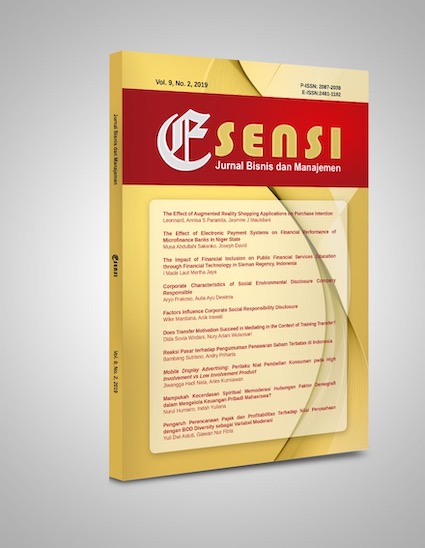The Impact of Financial Inclusion on Public Financial Services Education through Financial Technology in Sleman Regency, Indonesia
DOI:
https://doi.org/10.15408/ess.v9i2.13576Keywords:
financial inclusion, financial technology, public financial services educationAbstract
The purpose of this study is to know the impact of financial inclusion on public financial services education through financial technology. This research was conducted in Sleman Regency because the area was quite large in Yogyakarta, and was ranked third. This type of research is quantitative research. Data collection methods used are questionnaires and literature studies. Data analyses used in this study are the validity test, reliability test, descriptive statistical test, and SEM (Structural Equation Modeling) analysis test. The results of this study found that financial inclusion has been proven to have no impact on public financial services education. However, financial inclusion has proven to have a significant impact on financial technology in Sleman Regency in 2018. In addition, financial inclusion through financial technology has also proven to have a positive impact on public financial service education in Sleman Regency in 2018.
References
Allen, Franklin, Asli Demirguc-Kunt, Leora Klapper, and Maria Soledad Martinez Peria. 2012. "The Foundations of Financial Inclusion: Understanding Ownership and Use of Formal Accounts." World Bank Policy Research Working Paper.
Arner, D.W., Barberis, J., and Buckley, R.P. (2015). The evolution of FinTech : A new post-crises paradigm?. University of Hong Kong.
Awrey, D. (2013). Toward a supply-side theory of financial innovation. Journal of Comparative Economics Vol. 41(2). pp. 401–419
Bank Indonesia. (2014). Booklet Keuangan Inklusif. Departemen Pengembangan Akses Keuangan dan UMKM.
Bank Indonesia. (2018). Laporan Publikasi. Jakarta: Bank Indonesia
Beck T., Demirgüç-Kunt A., Levine R. (2000). A New Database on the Structure and Development of the Financial Sector. World Bank Economic Review 14 (3), 597-605.
Bernanke, B. S. (2009). Financial innovation and consumer protection. Speech at the Federal Reserve System’s Sixth Biennial Community Affairs Research Conference, Washington, D.C., 17 April 2009
Brigham dan Houston. (2010). Dasar-dasar Manajemen Keuangan Buku 1 (edisi II). Jakarta: Salemba Empat.
Buckland, J., Guenther, B., Boichev, G., Geddie, H. dan Mutch, M. (2005). There are no banks here‟: financial and insurance exclusion services in Winnipeg‟s North End. Winnipeg Inner-city Research Alliance
Capuano, A., & Ramsay, I. (2011). What Causes Suboptimal Financial Behaviour? An Exploration of Financial Literacy Social Influences And Behavioural Economics.
Cheng X., & Degryse, H. (2006). The Impact of Bank and Non-Bank Financial Institutions on Local Economic Growth in China
De Haan, J. Oosterloo, S., & Schoenmaker, D. (2015). Financial markets and institutions : A European perspective. 3rd edition, Cambridge: Cambridge University Press.
Financial Stability Board [FSB]. (2017a). FinTech credit : Market structure, business models and financial stability implications. May 2017.
Financial Stability Board [FSB]. (2017b). Financial stability implications from fintech. 27 June 2017.
Griffoli, T. M. (2017). Banking on change. Finance & Development (September), Vol. 54, No. 3. Washington DC, International Monetary Funds
He, D., et al. (2017). Fintech and financial services: Initial considerations. IMF Staff Discussion Notes No. 17/05 (June). Washington DC, International Monetary Funds.
Kempson E, A. Atkinson., & Pilley, O. (2004). Policy level response to financial exclusion in developed economies: lessons for developing countries. Report of Personal Finance Research Centre, University of Bristol.
Merton, Robert C., and Zvi Bodie. (1995). Financial Infrastructure and Public Policy: A Functional Perspective. In The Global Financial System: A Functional Perspective.
Modigliani, F. (1986). Life Cycle, Individual Thrift and The Wealth of Nations. American Economic Review, Vol. 76, hal. 297-217.
Monticone, C. (2010). Financial Literacy and Financial Advice Theory and Empirical Evidence.
Nengsih, Novia. (2015). Peran Perbankan Syariah dalam Mengimplementasikan Keuangan Inklusif di Indonesia. Etikonomi, 14(2): 221-240.
Ozili, Peterson Kitakogelu. (2018). Impact of Digital Finance on Financial Inclusion and Stability. University of Essex. MPRA Paper No. 84771.
Peachey, Stephen and A. Roe. (2004). Access to Finance: A Study for the World Savings Banks Institute. Oxford:Oxford Policy Management, October.
Smith, A. (1776). An Inquiry into the Nature of Causes of the Wealth of Nations in Skusen, M. (2005). Sang Maestro Teori-teori Ekonomi Modern. Jakarta: Prenada.
Sugiyono. (2011). Metode Penelitian Kuantitatif, Kualitatif dan R&D. Bandung:Afabeta.
Sujarweni., & Wiratna, V. (2018). Panduan Mudah Olah Data Struktural Equation Modeling (SEM) Dengan Lisrel. Pustaka Baru: Yogyakarta.
Supartoyo, Y. H., Tatuh, J., & Sendouw, R. H. E. (2013). The Economic Growth and The Regional Characteristics: The Case of Indonesia. Buletin Ekonomi Moneter Dan Perbankan, Vol July, 3–19.
Syamsuddin, Lukman. (2010). Manajemen Keuangan Perusahaan. Jakarta: Rajawali Pers.
Thiel, M. (2001). Finance and Growth: A Review of Theory and the Available Evidence, Directorate General for Economic and Financial Affairs, Economic Paper No. 158.
Wachira MI, Kihiu EN. (2012). Impact of financial literacy on access to financial services in Kenya. International Journal of Business and Social Sience. Vol 3 No.19.
Xu, Lisa., dan Bilal Zia. (2012). Financial Literacy around the World-An Overview of the Evidence with Practical Suggestions for the Way Forward. The World Bank:Finance and Private Sector Development.

